How America Clicked
A brief history of the TV remote control.By Harry McCracken | Thursday, May 26, 2011 at 1:52 am
 Nobody is ever going to list the TV remote as one of the most important inventions of all time. Maybe not even of the second half of the twentieth century. But if the remote had never been invented, life would be meaningfully different. Think about it: if we all still had to get up from our couches and trudge across the room to change the station, there’d be no such thing as channel surfing. (Then again, we’d be thinner from the calories we burned.) Dealing with more than a handful of stations would be impossibly unwieldy, too–no remote control, no 500-channel universe.
Nobody is ever going to list the TV remote as one of the most important inventions of all time. Maybe not even of the second half of the twentieth century. But if the remote had never been invented, life would be meaningfully different. Think about it: if we all still had to get up from our couches and trudge across the room to change the station, there’d be no such thing as channel surfing. (Then again, we’d be thinner from the calories we burned.) Dealing with more than a handful of stations would be impossibly unwieldy, too–no remote control, no 500-channel universe.
In short, the TV remote matters–and it’s it worth pausing to remember some of the most significant models to appear since 1950, plus a not-so-significant curiosity or two. (Click on the images below to see the ads, patents, and magazine pages at a much larger size.)
 Lazy, indeed. In 1950, Zenith introduced America to the whole mindbending idea of controlling a TV from across the room. It did so with a remote with an inspired name: Lazy Bones. (Too bad it didn’t catch on as a generic term for the entire category.) Lazy Bones only let you change the station. And it’s not clear in this ad, but it was a wired remote. Even that was a mighty appealing concept –and wired remotes lasted at least into the 1980s. (My first VCR had one.)
Lazy, indeed. In 1950, Zenith introduced America to the whole mindbending idea of controlling a TV from across the room. It did so with a remote with an inspired name: Lazy Bones. (Too bad it didn’t catch on as a generic term for the entire category.) Lazy Bones only let you change the station. And it’s not clear in this ad, but it was a wired remote. Even that was a mighty appealing concept –and wired remotes lasted at least into the 1980s. (My first VCR had one.)
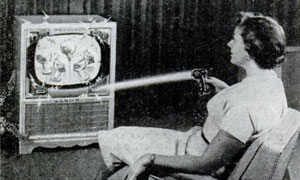 Shoot your TV. Five years later, Zenith rendered Lazy Bones obsolete with Flash-Matic, its first wireless remote. It resembled a Buck Rogers ray-gun, and people using it in ads looked alarmingly like they were zapping their TV sets. But it was pretty much just a flashlight: you performed different functions by aiming it at different corners of the screen. One of its innovations: you could use it to mute the audio, which Zenith promoted as being a great antidote to pesky commercials.
Shoot your TV. Five years later, Zenith rendered Lazy Bones obsolete with Flash-Matic, its first wireless remote. It resembled a Buck Rogers ray-gun, and people using it in ads looked alarmingly like they were zapping their TV sets. But it was pretty much just a flashlight: you performed different functions by aiming it at different corners of the screen. One of its innovations: you could use it to mute the audio, which Zenith promoted as being a great antidote to pesky commercials.
 Sound Off! In 1956, Zenith tried yet another technology: ultrasound. Using a Clapper-like approach, the Space Command emitted clicks which were picked up by a mike inside the TV. One catch: Other high-pitched sounds, such as a dog tag’s jingle, sometimes switched channels. This 1960 ad shows a swanky couple in a swanky room watching a swanky lady on a swanky TV with the wondrous Glare-Ban feature. (The set sold for $575, or $4200 in 2011 dollars).
Sound Off! In 1956, Zenith tried yet another technology: ultrasound. Using a Clapper-like approach, the Space Command emitted clicks which were picked up by a mike inside the TV. One catch: Other high-pitched sounds, such as a dog tag’s jingle, sometimes switched channels. This 1960 ad shows a swanky couple in a swanky room watching a swanky lady on a swanky TV with the wondrous Glare-Ban feature. (The set sold for $575, or $4200 in 2011 dollars).
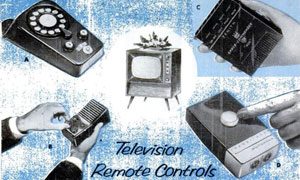 The wide world of remotes. In the mid-fifties, TV makers were still figuring out what a remote should look like and what features it should have, as shown in this illustration from Popular Mechanics. Dumont (upper left) gave its one a telephone-like rotary dial. Emerson (lower left) thought it should have a built-in speaker. Motorola (lower right) opted for Apple-like minimalism with its one-button model. And that’s an early Zenith Space Command at upper right.
The wide world of remotes. In the mid-fifties, TV makers were still figuring out what a remote should look like and what features it should have, as shown in this illustration from Popular Mechanics. Dumont (upper left) gave its one a telephone-like rotary dial. Emerson (lower left) thought it should have a built-in speaker. Motorola (lower right) opted for Apple-like minimalism with its one-button model. And that’s an early Zenith Space Command at upper right.
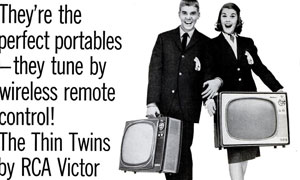 Remotely portable. At first, the very fact that a television had a remote control of any sort was a sure sign it was a high-end model. By 1959, the technology began to work its way down to lower-priced, more mainstream models–such as the “portable” sets being hefted by the alarmingly perky young folks in this RCA Victor ad. The sets came with RCA’s Wireless Wizard remotes, and sold for as little as $149.95. (That’s $1100 in today’s dollars–but still cheap for a 1959 TV.)
Remotely portable. At first, the very fact that a television had a remote control of any sort was a sure sign it was a high-end model. By 1959, the technology began to work its way down to lower-priced, more mainstream models–such as the “portable” sets being hefted by the alarmingly perky young folks in this RCA Victor ad. The sets came with RCA’s Wireless Wizard remotes, and sold for as little as $149.95. (That’s $1100 in today’s dollars–but still cheap for a 1959 TV.)
 Being digital. Early remotes made you movie through channels one station at a time, in sequential rather than random-access fashion. Which was fine if you only got a few channels. But Magnavox’s 1974 model added a major new feature: a keypad. You could punch the buttons to go directly to any channel, and (apparently humongous) numbers showed you which channel you were on. This miracle of channel-hopping goodness set the standard for every TV remote that followed.
Being digital. Early remotes made you movie through channels one station at a time, in sequential rather than random-access fashion. Which was fine if you only got a few channels. But Magnavox’s 1974 model added a major new feature: a keypad. You could punch the buttons to go directly to any channel, and (apparently humongous) numbers showed you which channel you were on. This miracle of channel-hopping goodness set the standard for every TV remote that followed.
 Simply infrared. In 2011, infrared technology is mundane. Very, very mundane. Back in 1977, however, it was a big deal that warranted a Popular Mechanics story, since it didn’t suffer from the irritating tendency of ultrasonic remotes to respond to noises other than TV watchers clicking their clickers. Infrared got the job done–and became such a dirt-cheap commodity that there’s hardly a gizmo in existence that would benefit from a remote that doesn’t come with one.
Simply infrared. In 2011, infrared technology is mundane. Very, very mundane. Back in 1977, however, it was a big deal that warranted a Popular Mechanics story, since it didn’t suffer from the irritating tendency of ultrasonic remotes to respond to noises other than TV watchers clicking their clickers. Infrared got the job done–and became such a dirt-cheap commodity that there’s hardly a gizmo in existence that would benefit from a remote that doesn’t come with one.
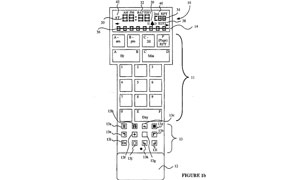 Woz’s other breakthrough. You know and love Steve Wozniak as cofounder of Apple and the engineering virtuoso behind the the Apple II. Less known: He was a key figure in remote-controi history, having cofounded CL 9, the company that invented the universal remote. Its $200 CORE trainable remote debuted in 1987; this drawing is from its patent filing. Like the Apple II, CORE packed a 6502 CPU; it was kind of geeky and didn’t catch on. But its descendants are legion.
Woz’s other breakthrough. You know and love Steve Wozniak as cofounder of Apple and the engineering virtuoso behind the the Apple II. Less known: He was a key figure in remote-controi history, having cofounded CL 9, the company that invented the universal remote. Its $200 CORE trainable remote debuted in 1987; this drawing is from its patent filing. Like the Apple II, CORE packed a 6502 CPU; it was kind of geeky and didn’t catch on. But its descendants are legion.
 Nerdly wonder. What if a designer of pocket calculators was forced at gunpoint to design a remote control? He’d probably come up with something along the lines of Radio Shack’s 1991 $99 eight-in-one universal model. Like Woz’s CORE, it could be trained to mimic any remote and let users set up macros to trigger sequences of events at particular times. It too was apparently too techy for the average consumer; the Shack didn’t sell them for long. I had one and adored it.
Nerdly wonder. What if a designer of pocket calculators was forced at gunpoint to design a remote control? He’d probably come up with something along the lines of Radio Shack’s 1991 $99 eight-in-one universal model. Like Woz’s CORE, it could be trained to mimic any remote and let users set up macros to trigger sequences of events at particular times. It too was apparently too techy for the average consumer; the Shack didn’t sell them for long. I had one and adored it.
 Interactivism. The media business keeps inventing interactive TV over and over–anyone remember QUBE?–without consumers ever quite buying into it. The idea usually involves a fancy-schmancy remote. In 1992, Popular Mechanics reported on Interactive Network’s trials in Northern California, which involved this remote with buttons, a big LCD–and a built-in dial-up modem. It let folks do stuff like play along with Wheel of Fortune.
Interactivism. The media business keeps inventing interactive TV over and over–anyone remember QUBE?–without consumers ever quite buying into it. The idea usually involves a fancy-schmancy remote. In 1992, Popular Mechanics reported on Interactive Network’s trials in Northern California, which involved this remote with buttons, a big LCD–and a built-in dial-up modem. It let folks do stuff like play along with Wheel of Fortune.
 Patently silly. As with tech products of all sorts, the history of the remote control is rife with fresh, original approaches to an old idea that got patented–and then preceded to go absolutely nowhere. The fellow in the patent drawing here–he looks awfully comfortable–is using a rather scary-looking joystick with a numeric keypad and a bunch of other miscellaneous buttons. Naturally, its inventor said that it was a particularly ergonomic design.
Patently silly. As with tech products of all sorts, the history of the remote control is rife with fresh, original approaches to an old idea that got patented–and then preceded to go absolutely nowhere. The fellow in the patent drawing here–he looks awfully comfortable–is using a rather scary-looking joystick with a numeric keypad and a bunch of other miscellaneous buttons. Naturally, its inventor said that it was a particularly ergonomic design.
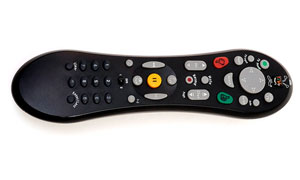 Mr. Peanut. The TiVo remote may the most iconic new-and-impoved remote control of its era–it’s synonymous not only with TiVo itself, but with user-friendly consumer-electronics interfaces in general. And yet, it’s not that dramatic a rethinking of the remote. It’s just that the shape is appealing and the buttons are thoughtfully arranged and well-labled. There’s a lesson there for everyone who’s attempted to radically rethink the remote over the years.
Mr. Peanut. The TiVo remote may the most iconic new-and-impoved remote control of its era–it’s synonymous not only with TiVo itself, but with user-friendly consumer-electronics interfaces in general. And yet, it’s not that dramatic a rethinking of the remote. It’s just that the shape is appealing and the buttons are thoughtfully arranged and well-labled. There’s a lesson there for everyone who’s attempted to radically rethink the remote over the years.
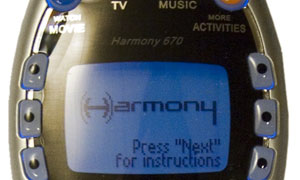 Peace and harmony. When the first Harmony remote–not yet a Logitech product–debuted in 2001, it brought with it the most powerful new idea in TV remote-control in years. Rather than forcing you to train it or relying on a stale list of supported remotes, this universal remote could be connected to a computer via USB cable and programmed over the Internet–letting it support a near-infinite list of consumer-electronics products, with no guesswork required.
Peace and harmony. When the first Harmony remote–not yet a Logitech product–debuted in 2001, it brought with it the most powerful new idea in TV remote-control in years. Rather than forcing you to train it or relying on a stale list of supported remotes, this universal remote could be connected to a computer via USB cable and programmed over the Internet–letting it support a near-infinite list of consumer-electronics products, with no guesswork required.
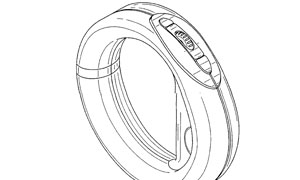 Circular thinking. Hillcrest Labs’ The Loop looks like another whacko, ill-advised alternative remote that never left the drawing board. But it is indeed for sale, and having used one, I’m…kind of impressed. Strictly speaking, this vaguely Wiimote-esque device (which you grasp like a brass ring) is as much mouse as remote–it’s intended for use with PCs that have been hooked up to TVs. Side benefits: it would look good on a coffee table, and would be tough to lose behind sofa cushions.
Circular thinking. Hillcrest Labs’ The Loop looks like another whacko, ill-advised alternative remote that never left the drawing board. But it is indeed for sale, and having used one, I’m…kind of impressed. Strictly speaking, this vaguely Wiimote-esque device (which you grasp like a brass ring) is as much mouse as remote–it’s intended for use with PCs that have been hooked up to TVs. Side benefits: it would look good on a coffee table, and would be tough to lose behind sofa cushions.
 QWERTYmania. When photos of Sony’s super-sized, remote for its Google TV-equipped sets leaked, some people wondered if they were a twisted joke. Nope. I find it oddly touching that Sony (and others, like the Boxee Box folk) have attempted to design the remote of the future by reaching back to Christopher Sholes’ QWERTY typewriter keyboard layout of the late 19th century. If the inventors of Zenith’s Lazy Bones could see this, they might dismiss it as objectionably old-fashioned.
QWERTYmania. When photos of Sony’s super-sized, remote for its Google TV-equipped sets leaked, some people wondered if they were a twisted joke. Nope. I find it oddly touching that Sony (and others, like the Boxee Box folk) have attempted to design the remote of the future by reaching back to Christopher Sholes’ QWERTY typewriter keyboard layout of the late 19th century. If the inventors of Zenith’s Lazy Bones could see this, they might dismiss it as objectionably old-fashioned.
 Ditch your clicker. Today, if you were building the perfect remote, you might give it a color touch screen, a rich user interface, Wi-Fi connectivity, and content downloaded from the Internet. But why bother to build it when you’re already carrying that hardware–in the form of your smartphone? Peel is a slick iPhone add-on that does just that, with mostly pleasing results. It and other phone-based remotes suggest that the true remote of the future may be no remote at all.
Ditch your clicker. Today, if you were building the perfect remote, you might give it a color touch screen, a rich user interface, Wi-Fi connectivity, and content downloaded from the Internet. But why bother to build it when you’re already carrying that hardware–in the form of your smartphone? Peel is a slick iPhone add-on that does just that, with mostly pleasing results. It and other phone-based remotes suggest that the true remote of the future may be no remote at all.
So what remote controls do you love–or love to hate?
13 Comments
Read more:













May 26th, 2011 at 3:19 am
Well remote controls have definately changed a lot. This article reminded me of the film "Click" 🙂
May 26th, 2011 at 4:52 am
This reminds me of my grandfather. He couldn't stand the loud commercials, so he did some soldering on the volume control, and connected a lamp switch to a long cord that ran across the living room. It was a big honor when he would let me flip the switch!
May 30th, 2011 at 9:36 am
That's funny because I did the same thing as a kid for my grandfather. Long cord to a lamp switch jumping the wires to the TV's speaker. He loved that switch and I clearly remember watching football games with him.
May 26th, 2011 at 7:27 am
I've had several all in one remotes, abut the best ones seemed to be from Sony, at least at the time. But the problem was it did 98% of what I needed it to do, but had to revert back to ones that came with devices at times to do everything.
May 26th, 2011 at 9:11 am
You know, the Kinect might be a blueprint for a remote. I do control netflix quite well with it. The tech could easily be translated to various other products.
May 26th, 2011 at 9:55 am
My favorite remote control story came from a friend, who was starving his way through college fixing TV sets. A set came into the shop with the complaint that it turned itself on in the middle of the night.
An examination revealed that the set was wired for a remote ultrasonic control. The owners had no idea that the set could be remotely controlled; they'd never seen the control.
Finally, my friend asked if there were anything in their house that might accidentally generate high frequency or ultrasonic sounds.
"Would bed springs to it?" he was asked.
One gets a mental image of nocturnal activity interrupted when the TV suddenly turns itself on.
June 18th, 2011 at 7:27 am
My dad had a free remote back in the 1960's, and that was even if the device never had a remote made for it.
This devicy was called children, no batteries ever needed and all he needed was a voice to control, no education or button learning needed.
June 18th, 2011 at 7:44 am
My idea remote would be a programmable touch screen, they have them now but almost a Grand to by one. When they reach my price range of $50 I'll get one to replace my collection of 14 remotes.
I hace a HD Dish box, LCD HD TV, HD TV antenna pointer, Digital/Analog AM/FM tuner/amp, Surround Sound system, and Two VCR's one is a Dual Deck, other is S-VHS, 2 DVD players, DVD recorder/Video editor. And my UPS power units (3 total) and a Sound Bar that almost does better than my 5.1 speaker system but far better control on the remote.
June 18th, 2011 at 7:48 am
And forgot my next toy a Google TV box for my HD Dish system, thanks to the Wi-Fi feature I do not need to add hsardware to connect to my DSL internet line. That I plan to get this holiday season.
June 22nd, 2011 at 9:43 am
We used to have a TV like that (the one under “Being Digital”). Our TV went out and we got that one pretty cheap. You could hear the ultrasonic sounds when you hit the buttons. On our TV, after you typed in your channel and the TV tuned in, the numbers would zoom away to become smaller until it was gone.
July 30th, 2011 at 4:26 pm
Ha my parents are always going on about how much technology has changed and how the term "computers in every home" was once a mystery lol
October 19th, 2011 at 11:43 am
What a great article, I found this to be quite an enjoyable read.
San Antonio chiropractor
February 6th, 2012 at 8:14 am
Instructive, in-depth article. Thanks very much! I really enjoyed reading it.